The Sahel. The Elegance of Nomads.
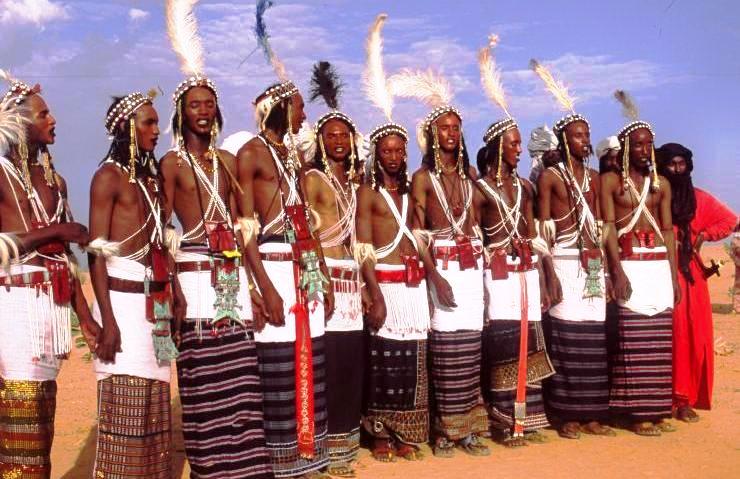
For desert shepherds, elegance and grace are antidotes to the desolation and hostility of the environment. Their cult of beauty has an identity value that hides profound social implications, as demonstrated by the significance of the turbans and Saharan makeup.
Although they live in the desert or arid lands, the Tuareg and the Peul, nomads devoted to pastoralism, do not give up caring for their physical appearance: self-care, however, is never an end in itself, but always oriented towards socially defined purposes.
The two peoples, scattered over a large part of the Sahara and the Sahel, live in contiguous territories and this has stimulated fierce friction or deep collaboration, depending on the circumstances.
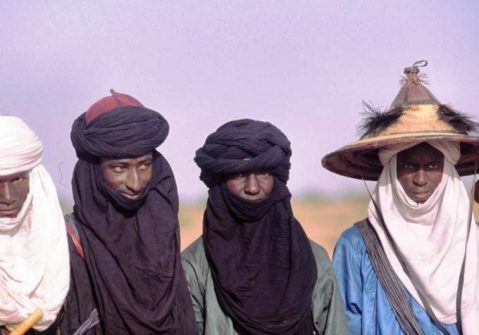
the Tuareg and the Peul, nomads devoted to pastoralism are scattered over a large part of the Sahara and the Sahel.
In Mali and Burkina Faso, the tensions that see them as protagonists are lacerating, but in Niger, at the end of the rainy season, anyone wandering around the golden savannahs around Abalak would find dozens of Tuareg and Peul families moving to reach the same pastures rich in salt and good for their animals.
The closeness between the two groups in Niger is such that the Peul have taken on some of the typical elements of the Tuareg parure in their clothing, such as the turban, the traditional sword, called takuba, and the red leather cases to be worn around the neck and displayed towards the front, useful for holding tobacco or money.
The sharing of the same spaces, however extensive, has favoured the migration of aesthetic details from one group to another, as proof of the porosity of each ethnic group and of the openness to adopt features of other contiguous ones.
Discretion and pride
Generally, there is no family or village celebration, or even a simple visit to relatives or acquaintances, which is not an excuse to dress in a certain way and decorate oneself and the dromedaries with an abundance of carefully painted leather harnesses, to use the best saddle and to wrap meters of fabric around the head for the turban, the element that more than any other identifies the men of this group.
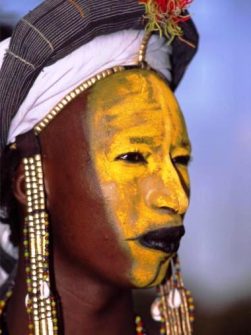
“A word that must be raised, fed and trained; the word as something to take care of like the body or clothing”.
The tagelmust is a long cotton band, usually between 3 and 5 meters long, but which can also reach 10, dyed indigo and wrapped around the head and face of the Tuareg so as to form both a turban and a veil which covers the face, leaving only a slit open for the eyes. The tagelmust is part of the clothing of every Tuareg but above all, it is an integral part of the way of behaving, it is an emanation of the code of values in which discretion and pride are intertwined.
The band on the forehead of the turban is called asshak and represents all the things that make a man worthy of being called as much.
Words to be shepherded
The part that covers the mouth and nose, called tenna, represents the ability to keep faith with what is said, with one’s word. In the context of a pastoral culture centred on transhumance and the daily care of animals, in a society where everyone, except blacksmiths, is also a shepherd, to think that the attention paid to the word implies the same sense of caring for animals and that therefore the man through the veil is the shepherd of his own word gives the measure of the attention, of the thoughtfulness, of the reflection with which the word is used, as precious as the heads of cattle. A word that must be raised, fed and trained; the word as something to take care of like the body or clothing. Tradition has it that the eyes, ears, and nose are covered as much as possible by the veil both to protect against the wind, sun and cold and to prevent bad spirits from infiltrating the orifices.
Different turbans
Therefore, the use of the turban, such an eye-catching and distinctive element of the aesthetic aspect of the Tuaregs, arises from practical needs related to the environment as well as from spiritual beliefs and, as a consequence, confers mystery and majesty on men, removing what is human, of truth, which is in every face.
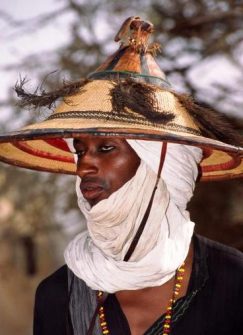
The turban represents the identity of a group and at the same time each one’s personality.
It is representative of the identity of a group and at the same time of each one’s personality, as each man wraps it in his own way by superimposing the band of fabric in multiple concentric turns: some make it into a large pot-bellied doughnut, some compose it vertically creating a sort of cylinder, fitting the end that closes the bands in a charming and showy way creating a sort of bow. During daily activities, the turbans worn are those of ‘work’, worn and soiled but never wrapped carelessly or badly.
The classic festival veil, called alesho, made of at least fifty narrow bands of cotton fabric sewn together and dyed with indigo, is used only in ceremonial circumstances. The colour with which the fabric is soaked is not indelibly fixed since there is no mordant for indigo, which releases bluish shades with metallic reflections on the skin, and it is foreseen that these are left both to protect the skin and because the face, tanned in this way, is aesthetically very appreciated.
Code of conduct
Among the Peul, there is a code of behaviour that inspires everyone, the pulaaku, which dictates not only the rules of action to be worthy of calling oneself Peul but also the rules of speaking, the tone of voice, one’s appearance and one’s pose. Carriage and good manners are absolute values among the Peul and should be celebrated together with the concept of tappel, physical beauty.
Proud of their looks, the Wodaabe shepherds (a fraction of the Peul world scattered between Niger and Chad) gather every year in the heart of the Sahel at the end of the rainy season on the occasion of Gerewol, a sort of great vanity festival that celebrates the beauty of nomads and it is the occasion when marriages are arranged.
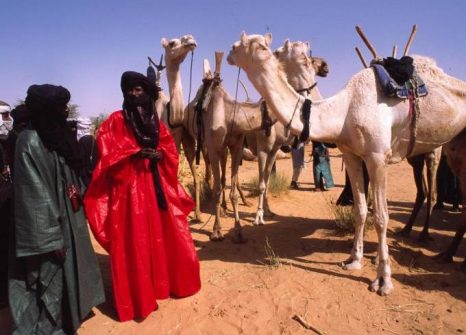
A pastoral culture centred on transhumance and the daily care of animals.
Exuberantly dressed and made up, the young people flaunt their physical prowess and give life to a spectacular ceremony made up of sensual dances and alluring glances. It is not a simple beauty contest, but an aesthetic ritual that has a profound social value. These ceremonies, by encouraging marriages between members of different clans, are a valuable tool for strengthening the cohesion of an otherwise very fragmented ethnic group. For seven days and seven nights the dancers of two different lineages, by previous agreement, confront each other in a battle with dances and songs whose protagonists are the men on the stage and the women are objects of seduction and potential candidates for new marriages.
Caring for one’s own body
The young nomads spend hours putting on make-up and dancing, showing off their physical beauty and graceful posture as well as their ability to move to reproduce the movements of the long-legged white heron resting on oxen. Self-care and attention to beauty are part of the process of building a relationship with the environment: in a world of thorns, prickly herbs, muddy water, only summer rains if all goes well, scorpions in the dark and merciless suns, the pulaaku, in imposing, among other things, grace, a certain posture and the care of one’s body, feeds a constant yearning for the absolute value of beauty.
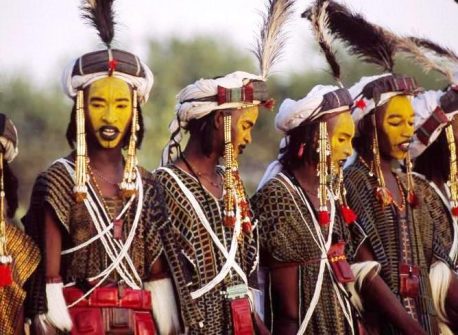
The young nomads spend hours putting on make-up and dancing, showing off their physical beauty and graceful posture.
Taking care of one’s body and adorning it even in carrying out daily practices has to do with the rules that regulate the daily relationship with the other, marked by reserve and elegance in manner and tone, but even more: the more the environment is hostile, the gentler one must read on it. The Sahelian undergrowth is insidious, and only postural and gestural elegance allows one to relate to it with a straight back. (Photos: Francesca Mascotto)
Elena Dak/Africa



